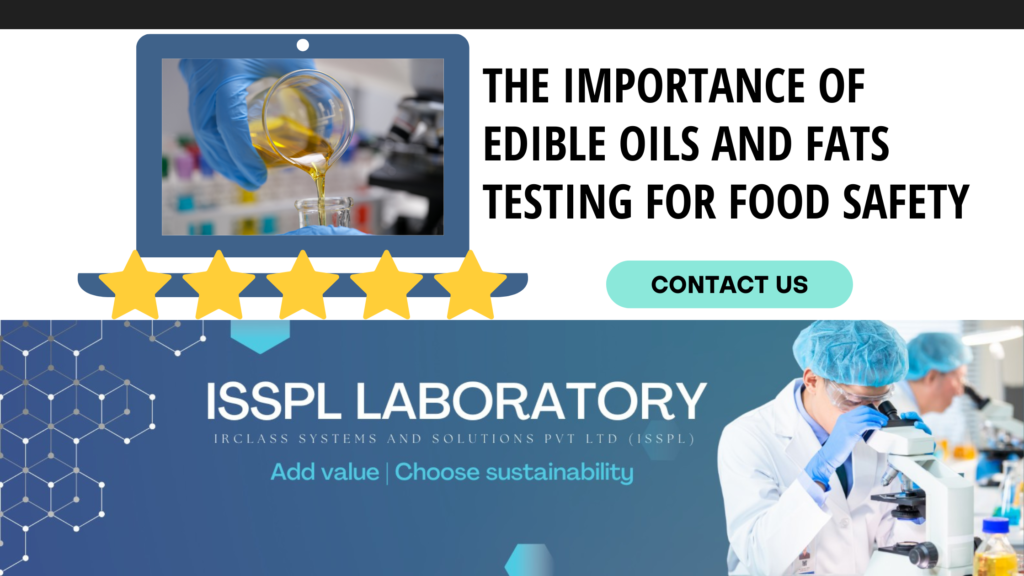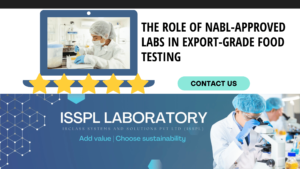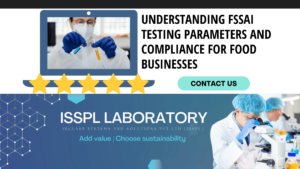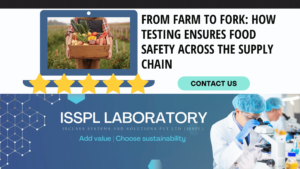An Overview by Team ISSPL - Analytical Testing Laboratory in India
ToggleFats and oils are the components that are consumed daily in our diets. They provide the body with vital energy, assist in the absorption of vitamins, and improve the texture and taste of the foods we consume.
Examples of liquid oils are sunflower oil, olive oil, and canola oil, while some of the solid animal fats are butter and lard, which are mostly used in cooking and baking. Nevertheless, it is necessary to keep these oils and fats safe to eat to ensure consumers’ health. This is where the testing of edible oils and fats becomes very important.
In this blog, we will be talking about why testing of edible oils and fats is important, the tests that are conducted, importance of testing, and how testing improves food security.
Understanding Edible Oils and Fats
Edible oils and fats are grouped into two main categories, and these are: vegetable oils and animal fats. Common examples include:
- Vegetable Oils: Sunflower oil, soybean oil, olive oil, canola oil, coconut oil, and palm oil.
- Animal Fats: Butter, lard, tallow, and ghee.
- Specialty Oils: Flaxseed oil, avocado oil, and sesame oil.
These oils and fats are used for cooking and frying and are also used in the preparation of many processed foods, bakery products, and confectioneries. They are important in enhancing taste, sources of essential fatty acids, and fat-soluble vitamins A, D, E, and K.
Despite the fact that oils and fats are vital nutrients in our diet, they are prone to be contaminated, oxidized, or adulterated. When not well tested, they pose a health risk to the consumer.
Why Is Testing Edible Oils and Fats Important?
For this reason, it is wise that edible oils and fats be analyzed for several reasons that all work towards ensuring that the food is safe and of the right quality. Here’s why testing is so crucial:
- Detecting Contaminants
There are three broad sources of impurities in the edible oils and fats, namely pre-harvest, harvest, and post-harvest. These contaminants may include:
- Pesticides used during farming.
- Dangerous compounds such as lead or mercury accumulated from the environment.
- Impurities introduced during the process of refining oil products.
In order not to have toxic oils, analysis is undertaken to identify these detrimental substances and the quantities involved.
- Preventing Adulteration
The contamination of edible oils is another familiar issue. It is also necessary to point out that low-grade oils contain additional amounts of better oils in order to reduce costs. For example, pure olive oil may be blended with low-quality soybean or palm oil. This not only misleads the consumer but may even injure them, especially allergic individuals, in their health. Testing also confirms that the oil is not mixed with any other substance, thus ensuring its purity. - Assessing Quality
To maintain the palatability, shelf life, and wholesomeness of the edible oils and fats, it is necessary to preserve their product attributes. Without testing, oils may go rancid or even lack their nutritional values. Analysis is used to check quality parameters such as free fatty acid and peroxide values, etc. - Ensuring Compliance with Regulations
The rules and regulations concerning the quality of the edible oils and fats that are consumed in all countries are in place. For example, there is a limitation on the amount of contaminants that can be allowed, and there is special labeling of nutritional values. Testing helps manufacturing companies conform to national and international standards, hence avoiding fines and legal issues. - Protecting Consumer Health
Finally, the most practical reason to test edible oils and fats is that consumers’ health is at risk. Consumption of risky or inferior oils leads to foodborne illnesses, organ ailments, and chronic diseases due to toxicity.
Common Tests for Edible Oils and Fats
To reach the desired safety and quality, some tests are done on the edible oils and fats. They include tests on characteristics such as contamination, perishability, nutritional value, and purity, respectively. Here are some of the most common tests:
- Free Fatty Acid (FFA) Test
This test determines the amount of free fatty acid in the oil sample in terms of percentage. It also measures FFA, which stands for hydrolytic rancidity and indicates the taste and shelf life of the oil. In other words, the FFA test is crucial when it comes to testing the freshness of the oil. - Peroxide Value (PV) Test
The peroxide value test establishes the primary oxidation products of the oil. Oxidation leads to rancidity, objectionable flavors, and odors in foods. High peroxide value indicates that the oil has reached its expiry period and therefore should be replaced. - P-Anisidine Value (AV) Test
This test measures the number of secondary oxidation products and gives a clearer picture of the capacity of the oil to resist oxidation. This test is often performed alongside the peroxide value test in a bid to get an overall assessment of the oil. - Iodine Value (IV) Test
The iodine value test measures the degree of unsaturation of the oil. The degree of unsaturation has a direct bearing on the oxidation sensitivity of the oils, and this factor determines the shelf life of the oils. - Saponification Value (SV) Test
The mean molecular weight of fatty acids is determined by this test, and it is an indication of the oil’s quality. It is useful for deciding between the kind of oil to apply as well as whether the kind used is suitable for the labeled use. - Moisture and Volatile Content Test
Excessive moisture in oils presents another hazard as far as microbial growth is concerned, leading to spoilage of oils. This test is very essential in determining whether the oil has been well refined and whether it has been well stored. - Adulteration Tests
There are tests conducted to determine the extent of adulteration of the oils. For instance, GC and FTIR can reveal whether the oil has been mixed with other forms of oils.

The Benefits of Regular Testing
Regular testing of edible oils and fats provides several benefits, including:
- Improved Food Safety
Analysis ensures that contaminants are wiped out or reduced to safe levels, making the oils safe for consumption. - Enhanced Quality Control
By monitoring important quality parameters, it becomes easier to guarantee that the products produced have the right taste and smell and also do not lack nutrients as per consumer expectations. - Consumer Trust
This makes the consumers trust the products, which in turn builds strong brand loyalty for manufacturers. - Compliance with Standards
Manufacturers who comply with food safety regulations avoid fines, legal issues, and product recalls. - Cost Savings
Testing can identify signs of flaws or contamination at an early stage, thereby reducing costs associated with losses, product recalls, and damage to reputation.
The Role of Testing Laboratories
The testing of edible oils and fats requires specific apparatus and techniques. Towards this end, laboratories with modern technology are essential in this process. They carry out numerous tests to determine the suitability of the oils and fats for safety, quality, and legal requirements.
Multidimensional testing services are provided by ISSPL (Integrated Scientific Services Private Limited) for almost every segment of society, including the food and agriculture sectors. Their services typically include:
- Tests to confirm the presence of other substances, such as pesticide or heavy metal residues.
- Conducting quality tests such as FFA, PV, and AV.
- Checking nutritional information and labeling.
- Detecting food product adulteration.
Manufacturers can achieve accurate results that increase food safety levels by outsourcing testing to a reliable lab.
How Testing Protects Public Health
Unlike other laboratory tests, testing of edible oils and fats is directly linked to the health of the people. Here are a few ways it contributes to a healthier society:
- Reducing Health Risks: Contaminated oils cause foodborne diseases, chronic diseases, and illnesses. Testing helps minimize these risks.
- Preventing Allergic Reactions: Some oils cause allergic reactions when blended improperly. Testing ensures oils meet specifications, protecting consumers.
- Promoting Nutritional Well-Being: Testing guarantees that consumers receive essential nutrients from oils.
- Protecting Vulnerable Populations: Newborns, the elderly, and those with weakened immunity are safeguarded from contaminated or substandard oils through testing.
Conclusion
The necessity of testing edible oils and fats cannot be overestimated. These are food substances that are very important in our diet, but the dangers of consuming untested oils are very high. Testing ensures oils are uncontaminated, unadulterated, and meet safety standards.
Testing also assists manufacturers in meeting regulations, increasing customer confidence, and avoiding product recalls. All companies involved in the production, processing, and distribution of edible oils and fats are encouraged to conduct regular testing.
If you are in a position to seek reliable testing services, laboratories like ISSPL are well-equipped with appropriate tools and skilled professionals to ensure food safety and quality. For more information on their services, visit ISSPL.







